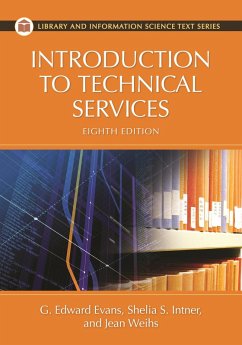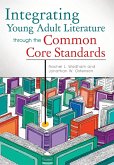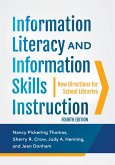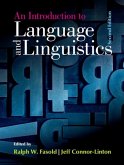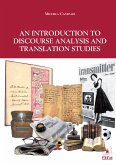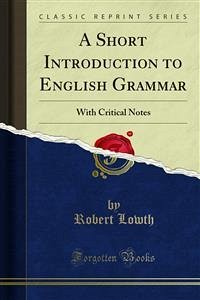54,95 €
54,95 €
inkl. MwSt.
Sofort per Download lieferbar

27 °P sammeln
54,95 €
Als Download kaufen

54,95 €
inkl. MwSt.
Sofort per Download lieferbar

27 °P sammeln
Jetzt verschenken
Alle Infos zum eBook verschenken
54,95 €
inkl. MwSt.
Sofort per Download lieferbar
Alle Infos zum eBook verschenken

27 °P sammeln
- Format: PDF
- Merkliste
- Auf die Merkliste
- Bewerten Bewerten
- Teilen
- Produkt teilen
- Produkterinnerung
- Produkterinnerung

Bitte loggen Sie sich zunächst in Ihr Kundenkonto ein oder registrieren Sie sich bei
bücher.de, um das eBook-Abo tolino select nutzen zu können.
Hier können Sie sich einloggen
Hier können Sie sich einloggen
Sie sind bereits eingeloggt. Klicken Sie auf 2. tolino select Abo, um fortzufahren.

Bitte loggen Sie sich zunächst in Ihr Kundenkonto ein oder registrieren Sie sich bei bücher.de, um das eBook-Abo tolino select nutzen zu können.
Used in library schools worldwide, this standard text provides students with a thorough understanding of technical services. Updated and expanded, the eighth edition further emphasizes the rapidly changing environment in which technical services are conducted. The book covers all aspects of the field-from acquisitions to managing the cataloging department-with five new chapters. "Technical Services Issues" includes material related to physical space needs; "E-resources Issues" examines how the growth of e-materials impact technical services work; "Copy Cataloging" reflects the ever increasing…mehr
- Geräte: PC
- mit Kopierschutz
- eBook Hilfe
- Größe: 26.06MB
Andere Kunden interessierten sich auch für
![Integrating Young Adult Literature through the Common Core Standards (eBook, PDF) Integrating Young Adult Literature through the Common Core Standards (eBook, PDF)]() Rachel L. WadhamIntegrating Young Adult Literature through the Common Core Standards (eBook, PDF)33,95 €
Rachel L. WadhamIntegrating Young Adult Literature through the Common Core Standards (eBook, PDF)33,95 €![Information Literacy and Information Skills Instruction (eBook, PDF) Information Literacy and Information Skills Instruction (eBook, PDF)]() Nancy Pickering ThomasInformation Literacy and Information Skills Instruction (eBook, PDF)40,95 €
Nancy Pickering ThomasInformation Literacy and Information Skills Instruction (eBook, PDF)40,95 €![Digital Literature and Critical Theory (eBook, PDF) Digital Literature and Critical Theory (eBook, PDF)]() Annika ElstermannDigital Literature and Critical Theory (eBook, PDF)37,95 €
Annika ElstermannDigital Literature and Critical Theory (eBook, PDF)37,95 €![Introduction to Language and Linguistics (eBook, PDF) Introduction to Language and Linguistics (eBook, PDF)]() Ralph FasoldIntroduction to Language and Linguistics (eBook, PDF)43,95 €
Ralph FasoldIntroduction to Language and Linguistics (eBook, PDF)43,95 €![Introduction to Language and Linguistics (eBook, PDF) Introduction to Language and Linguistics (eBook, PDF)]() Introduction to Language and Linguistics (eBook, PDF)46,95 €
Introduction to Language and Linguistics (eBook, PDF)46,95 €![An Introduction to Discourse Analysis and Translation Studies (eBook, PDF) An Introduction to Discourse Analysis and Translation Studies (eBook, PDF)]() Michela CanepariAn Introduction to Discourse Analysis and Translation Studies (eBook, PDF)5,99 €
Michela CanepariAn Introduction to Discourse Analysis and Translation Studies (eBook, PDF)5,99 €![A Short Introduction to English Grammar (eBook, PDF) A Short Introduction to English Grammar (eBook, PDF)]() Robert LowthA Short Introduction to English Grammar (eBook, PDF)6,85 €
Robert LowthA Short Introduction to English Grammar (eBook, PDF)6,85 €-
-
-
Used in library schools worldwide, this standard text provides students with a thorough understanding of technical services. Updated and expanded, the eighth edition further emphasizes the rapidly changing environment in which technical services are conducted. The book covers all aspects of the field-from acquisitions to managing the cataloging department-with five new chapters. "Technical Services Issues" includes material related to physical space needs; "E-resources Issues" examines how the growth of e-materials impact technical services work; "Copy Cataloging" reflects the ever increasing need to be more efficient and also to save limited funds for technical services activities; "Overview and Decisions" addresses the issue of why and how the local OPAC has become a gateway to the universe of knowledge; and "Processing Materials" covers the activities involved in making sure items that go into a library's collection are properly identified as belonging to the library and where the item is physically located in the collection. All other chapters have been extensively rewritten and updated to reflect 2010 technical service functions and activities. Complete with helpful illustrations, statistics, and study guide questions, this text is a must for library and information science students!
Produktdetails
- Produktdetails
- Verlag: Bloomsbury Publishing Inc
- Seitenzahl: 500
- Altersempfehlung: ab 7 Jahre
- Erscheinungstermin: 11. November 2010
- Englisch
- ISBN-13: 9781591588900
- Artikelnr.: 55102546
- Verlag: Bloomsbury Publishing Inc
- Seitenzahl: 500
- Altersempfehlung: ab 7 Jahre
- Erscheinungstermin: 11. November 2010
- Englisch
- ISBN-13: 9781591588900
- Artikelnr.: 55102546
- Herstellerkennzeichnung Die Herstellerinformationen sind derzeit nicht verfügbar.
G. Edward Evans, PhD, is a retired award-winning author and Fulbright Scholar. He holds several graduate degrees in anthropology and library and information science. As a researcher, he has published in both anthropology and LIS and held a Fulbright Fellowship and a National Science Foundation Fellowship. His teaching experience has also been in both fields in the United States and the Nordic countries, in particular at the Graduate School of Librarianship and Information Science at the University of California, Los Angeles.
Contents Preface to the Eighth Edition Part I: General Background Chapter
1: INTRODUCTION Libraries and Customer Service Customer Service Philosophy
Role of Library Services What are Technical Services? Technical Services
Background Knowledge Goals for Staff Summary Review Questions Notes
Suggested Reading Chapter 2: TECHNICAL SERVICES ADMINISTRATION Tips for
Effective Time Management Tips for Meetings Tips for Team Building Tips for
Staff Motivation Tips for Communication The "More" Factor The
Faster/Better/Cheaper Factors Restructuring to Provide "Faster and Better"
Standards Summary Review Questions Notes Suggested Reading Chapter 3:
STAFFING Staffing Categories Librarians Paraprofessional/Support Staff
Other Full-Time Staff Staffing Process Recruitment Selecting the Pool
Interviewing Staff Development, Training, and Retention Retention Training
and Development Performance Appraisal Part-Time Staff Students Volunteers
Summary Review Questions Notes Suggested Reading Chapter 4: TECHNICAL
SERVICES ISSUE Technology Outsourcing Cooperative/Consortial Activities
Quality Assurance Budgetary Issues Spaces for Technical Services Some Key
Issues Planning Issues Summary Review Questions Notes Suggested Reading
Part II: Acquisitions and Serials Chapter 5: ACQUISITIONS-OVERVIEW
Collection Development and Acquisitions Types of Materials Acquired Print
Materials Nonbook Materials Electronic Resources General Procedures Request
Processing Verifying Ordering Reporting Receiving Orders Acquisition
Methods Serials Processing Summary Review Questions Notes Selected Web
Sites and Discussion Lists Suggested Reading Chapter 6: DISTRIBUTORS AND
VENDORS Making the Selection-Factors to Consider What the Firm Stocks
Vendor Technological Capability Speed of Delivery Financial Considerations
Vendors' Services Customer Service Considerations Vendor Evaluation Retail
Outlets Out-of-Print, Antiquarian, and Rare Book Dealers Summary Review
Questions Notes Selected Web Sites Suggested Reading Chapter 7: PRINT AND
DIGITAL BOOKS What is Publishing? Types of Publishers Electronic Publishing
E-Readers Technology and Information Producers Acquisitions and E-Resources
The Google Books Library Project Summary Review Questions Notes Suggested
Reading Chapter 8: E-RESOURCE ISSUES Differences between E-Resource and
Print Collection Building Ownership Issues Negotiating the License Group
Decision Making Trials Purchase Price Staff and User Issues Technical
Issues Cancellations Assessment of E-Resources Statistics Summary Review
Questions Notes Suggested Reading Chapter 9: SERIALS-PRINT AND ELECTRONIC
What Is a Serial? Issues and Concerns Cost and Pricing Acquisition
Processing Access Preservation Backfiles Changing Nature Assessment and
Evaluation Summary Review Questions Notes Suggested Reading Chapter 10:
GOVERNMENT INFORMATION Background E-Government Categories of Government
Information U.S. Documents State and Local Governments Canadian Government
Information Documents from Other Countries Access to Government Information
Accessing U.S. Government Information Preservation of Government
Information Federal Depository Library Program Canadian Depository Programs
Acquisition of Government Information Summary Review Questions Notes
Suggested Reading Chapter 11: MEDIA Media Issues Current Media Formats
Motion Pictures and Video Movie Ratings and Libraries Video and Copyright
Other Image Formats Maps Audio Recordings Games Game Ratings Realia
Microforms Preservation Microforms Film and Video Summary Review Questions
Notes Suggested Reading Chapter 12: FISCAL MANAGEMENT Problems in Fiscal
Management Library Fund Accounting Accounting Balance Sheet Accounts and
Ledgers Journal Estimating Costs Allocation of Monies Encumbering Vouchers
Order and Invoice Control Reconciliation of Accounts Audits Summary Review
Questions Notes Suggested Reading Part III: Cataloging and Processing
Chapter 13: OVERVIEW AND DECISIONS The Rationale for Good Cataloging
Cataloging and Classification Processes Decisions Bibliographic Levels
Subject Authorities Classification Systems Catalog Displays A Word About
the Figures and Examples Summary Review Questions Notes Suggested Reading
Chapter 14: DESCRIPTION-IDENTIFYING MATERIALS AACR2: Past and Present
Organization of AACR2-2005 Descriptive Structure and Data Sources ISBD
Punctuation Creating the Description Area 1: Title and Statement of
Responsibility Area 2: Edition Statement Area 3: Material Specific Details
Area 4: Publication, Distribution, etc. Area 5: Physical Description Area
6: Series Area 7: Notes Area 8: Standard Numbers and Terms of Availability
Rule Interpretations Summary Review Questions Notes Suggested Reading
Chapter 15: ACCESS POINTS-RETRIEVING THE RECORD Main and Added Entries
Selecting the Main Entry Selection Decision Tree Added Entries Name and
Title Authorities Personal Names Corporate Bodies Geographic Names Uniform
Titles Summary Review Questions Notes Suggested Reading Chapter 16: SUBJECT
ANALYSIS Determining Subject Matter Enumeration versus Faceting Subject
Authorities: Subject Heading Vocabularies Principles of Subject Cataloging
Evaluating Subject Catalogs Problems of the Subject Catalog Subject
Authorities: Numbers for Classification Principles of Classification Call
Numbers Evaluating Classifications Maintenance Issues Subject Analysis for
Literary Works Why use Standard Systems? Summary Review Questions Notes
Suggested Reading Chapter 17: SUBJECT AUTHORITIES Library of Congress
Subject Headings The Publication Format of LCSH Entries Cross-References in
LCSH Subdivisions in LCSH Other Subdivision Instructions LCSH's Canadian
Complement Problems with LCSH LC's Children's and Young Adults' Cataloging
Program Sears List of Subject Headings The Publication Format of the
Entries Advantages and Disadvantages of Using Sears Summary Review
Questions Notes Suggested Reading Chapter 18: CLASSIFICATION SYSTEMS Dewey
Decimal Classification Format of DDC The Schedules A Closer Look at the
Schedules A Closer Look at the Tables Library of Congress Classification
Principles Underlying LCC Format of LCC Main Classes of LCC Subdivision in
LCC Comparison of DDC and LCC National Library of Medicine Classification
Background and Development Format of NLMC Main Classes and Subdivisions
NLMC in Libraries "Copy" Classification Summary Review Questions Notes
Suggested Reading Answers to the Classification Exercises Chapter 19: MARC
FORMAT AND METADATA Machine-Readable Cataloging History and Background
Elements of a MARC Record Fields Subfields Indicators Content Designation
MARC Displays Bibliographic Networks and Shared Cataloging Metadata Dublin
Core Metadata Encoding and Transmission Standard Metadata Object
Description Schema Summary Review Questions Notes Suggested Reading Chapter
20: COPY CATALOGING Policy Issues 1. Acceptability of Sources 2. Record
Fullness 3. Errors 4. Call Numbers 5. Tracings (Subject Headings and Added
Entries/Access Points Overview of the Operation Choosing the Source(s)
Summary Review Questions Note Suggested Reading Chapter 21: PROCESSING
MATERIALS Evidence of Library Ownership Location Information Recording and
Tracking Use Preservation and Security Summary Review Questions Notes
Suggested Reading Chapter 22: LEADING THE CATALOG DEPARTMENT Management
Tasks Needed Skills Department Policies and Procedures When Cataloging
Standards Change Writing a Policy Manual Adopting the Policy Manual Current
Issues Ten Hints for Leadership Patron Service First and Foremost Review
Questions Suggested Reading Indexes Topical Index to the Text Index to
Names Index to Figures Type of Media Access Points Description
Classification
1: INTRODUCTION Libraries and Customer Service Customer Service Philosophy
Role of Library Services What are Technical Services? Technical Services
Background Knowledge Goals for Staff Summary Review Questions Notes
Suggested Reading Chapter 2: TECHNICAL SERVICES ADMINISTRATION Tips for
Effective Time Management Tips for Meetings Tips for Team Building Tips for
Staff Motivation Tips for Communication The "More" Factor The
Faster/Better/Cheaper Factors Restructuring to Provide "Faster and Better"
Standards Summary Review Questions Notes Suggested Reading Chapter 3:
STAFFING Staffing Categories Librarians Paraprofessional/Support Staff
Other Full-Time Staff Staffing Process Recruitment Selecting the Pool
Interviewing Staff Development, Training, and Retention Retention Training
and Development Performance Appraisal Part-Time Staff Students Volunteers
Summary Review Questions Notes Suggested Reading Chapter 4: TECHNICAL
SERVICES ISSUE Technology Outsourcing Cooperative/Consortial Activities
Quality Assurance Budgetary Issues Spaces for Technical Services Some Key
Issues Planning Issues Summary Review Questions Notes Suggested Reading
Part II: Acquisitions and Serials Chapter 5: ACQUISITIONS-OVERVIEW
Collection Development and Acquisitions Types of Materials Acquired Print
Materials Nonbook Materials Electronic Resources General Procedures Request
Processing Verifying Ordering Reporting Receiving Orders Acquisition
Methods Serials Processing Summary Review Questions Notes Selected Web
Sites and Discussion Lists Suggested Reading Chapter 6: DISTRIBUTORS AND
VENDORS Making the Selection-Factors to Consider What the Firm Stocks
Vendor Technological Capability Speed of Delivery Financial Considerations
Vendors' Services Customer Service Considerations Vendor Evaluation Retail
Outlets Out-of-Print, Antiquarian, and Rare Book Dealers Summary Review
Questions Notes Selected Web Sites Suggested Reading Chapter 7: PRINT AND
DIGITAL BOOKS What is Publishing? Types of Publishers Electronic Publishing
E-Readers Technology and Information Producers Acquisitions and E-Resources
The Google Books Library Project Summary Review Questions Notes Suggested
Reading Chapter 8: E-RESOURCE ISSUES Differences between E-Resource and
Print Collection Building Ownership Issues Negotiating the License Group
Decision Making Trials Purchase Price Staff and User Issues Technical
Issues Cancellations Assessment of E-Resources Statistics Summary Review
Questions Notes Suggested Reading Chapter 9: SERIALS-PRINT AND ELECTRONIC
What Is a Serial? Issues and Concerns Cost and Pricing Acquisition
Processing Access Preservation Backfiles Changing Nature Assessment and
Evaluation Summary Review Questions Notes Suggested Reading Chapter 10:
GOVERNMENT INFORMATION Background E-Government Categories of Government
Information U.S. Documents State and Local Governments Canadian Government
Information Documents from Other Countries Access to Government Information
Accessing U.S. Government Information Preservation of Government
Information Federal Depository Library Program Canadian Depository Programs
Acquisition of Government Information Summary Review Questions Notes
Suggested Reading Chapter 11: MEDIA Media Issues Current Media Formats
Motion Pictures and Video Movie Ratings and Libraries Video and Copyright
Other Image Formats Maps Audio Recordings Games Game Ratings Realia
Microforms Preservation Microforms Film and Video Summary Review Questions
Notes Suggested Reading Chapter 12: FISCAL MANAGEMENT Problems in Fiscal
Management Library Fund Accounting Accounting Balance Sheet Accounts and
Ledgers Journal Estimating Costs Allocation of Monies Encumbering Vouchers
Order and Invoice Control Reconciliation of Accounts Audits Summary Review
Questions Notes Suggested Reading Part III: Cataloging and Processing
Chapter 13: OVERVIEW AND DECISIONS The Rationale for Good Cataloging
Cataloging and Classification Processes Decisions Bibliographic Levels
Subject Authorities Classification Systems Catalog Displays A Word About
the Figures and Examples Summary Review Questions Notes Suggested Reading
Chapter 14: DESCRIPTION-IDENTIFYING MATERIALS AACR2: Past and Present
Organization of AACR2-2005 Descriptive Structure and Data Sources ISBD
Punctuation Creating the Description Area 1: Title and Statement of
Responsibility Area 2: Edition Statement Area 3: Material Specific Details
Area 4: Publication, Distribution, etc. Area 5: Physical Description Area
6: Series Area 7: Notes Area 8: Standard Numbers and Terms of Availability
Rule Interpretations Summary Review Questions Notes Suggested Reading
Chapter 15: ACCESS POINTS-RETRIEVING THE RECORD Main and Added Entries
Selecting the Main Entry Selection Decision Tree Added Entries Name and
Title Authorities Personal Names Corporate Bodies Geographic Names Uniform
Titles Summary Review Questions Notes Suggested Reading Chapter 16: SUBJECT
ANALYSIS Determining Subject Matter Enumeration versus Faceting Subject
Authorities: Subject Heading Vocabularies Principles of Subject Cataloging
Evaluating Subject Catalogs Problems of the Subject Catalog Subject
Authorities: Numbers for Classification Principles of Classification Call
Numbers Evaluating Classifications Maintenance Issues Subject Analysis for
Literary Works Why use Standard Systems? Summary Review Questions Notes
Suggested Reading Chapter 17: SUBJECT AUTHORITIES Library of Congress
Subject Headings The Publication Format of LCSH Entries Cross-References in
LCSH Subdivisions in LCSH Other Subdivision Instructions LCSH's Canadian
Complement Problems with LCSH LC's Children's and Young Adults' Cataloging
Program Sears List of Subject Headings The Publication Format of the
Entries Advantages and Disadvantages of Using Sears Summary Review
Questions Notes Suggested Reading Chapter 18: CLASSIFICATION SYSTEMS Dewey
Decimal Classification Format of DDC The Schedules A Closer Look at the
Schedules A Closer Look at the Tables Library of Congress Classification
Principles Underlying LCC Format of LCC Main Classes of LCC Subdivision in
LCC Comparison of DDC and LCC National Library of Medicine Classification
Background and Development Format of NLMC Main Classes and Subdivisions
NLMC in Libraries "Copy" Classification Summary Review Questions Notes
Suggested Reading Answers to the Classification Exercises Chapter 19: MARC
FORMAT AND METADATA Machine-Readable Cataloging History and Background
Elements of a MARC Record Fields Subfields Indicators Content Designation
MARC Displays Bibliographic Networks and Shared Cataloging Metadata Dublin
Core Metadata Encoding and Transmission Standard Metadata Object
Description Schema Summary Review Questions Notes Suggested Reading Chapter
20: COPY CATALOGING Policy Issues 1. Acceptability of Sources 2. Record
Fullness 3. Errors 4. Call Numbers 5. Tracings (Subject Headings and Added
Entries/Access Points Overview of the Operation Choosing the Source(s)
Summary Review Questions Note Suggested Reading Chapter 21: PROCESSING
MATERIALS Evidence of Library Ownership Location Information Recording and
Tracking Use Preservation and Security Summary Review Questions Notes
Suggested Reading Chapter 22: LEADING THE CATALOG DEPARTMENT Management
Tasks Needed Skills Department Policies and Procedures When Cataloging
Standards Change Writing a Policy Manual Adopting the Policy Manual Current
Issues Ten Hints for Leadership Patron Service First and Foremost Review
Questions Suggested Reading Indexes Topical Index to the Text Index to
Names Index to Figures Type of Media Access Points Description
Classification
Contents Preface to the Eighth Edition Part I: General Background Chapter
1: INTRODUCTION Libraries and Customer Service Customer Service Philosophy
Role of Library Services What are Technical Services? Technical Services
Background Knowledge Goals for Staff Summary Review Questions Notes
Suggested Reading Chapter 2: TECHNICAL SERVICES ADMINISTRATION Tips for
Effective Time Management Tips for Meetings Tips for Team Building Tips for
Staff Motivation Tips for Communication The "More" Factor The
Faster/Better/Cheaper Factors Restructuring to Provide "Faster and Better"
Standards Summary Review Questions Notes Suggested Reading Chapter 3:
STAFFING Staffing Categories Librarians Paraprofessional/Support Staff
Other Full-Time Staff Staffing Process Recruitment Selecting the Pool
Interviewing Staff Development, Training, and Retention Retention Training
and Development Performance Appraisal Part-Time Staff Students Volunteers
Summary Review Questions Notes Suggested Reading Chapter 4: TECHNICAL
SERVICES ISSUE Technology Outsourcing Cooperative/Consortial Activities
Quality Assurance Budgetary Issues Spaces for Technical Services Some Key
Issues Planning Issues Summary Review Questions Notes Suggested Reading
Part II: Acquisitions and Serials Chapter 5: ACQUISITIONS-OVERVIEW
Collection Development and Acquisitions Types of Materials Acquired Print
Materials Nonbook Materials Electronic Resources General Procedures Request
Processing Verifying Ordering Reporting Receiving Orders Acquisition
Methods Serials Processing Summary Review Questions Notes Selected Web
Sites and Discussion Lists Suggested Reading Chapter 6: DISTRIBUTORS AND
VENDORS Making the Selection-Factors to Consider What the Firm Stocks
Vendor Technological Capability Speed of Delivery Financial Considerations
Vendors' Services Customer Service Considerations Vendor Evaluation Retail
Outlets Out-of-Print, Antiquarian, and Rare Book Dealers Summary Review
Questions Notes Selected Web Sites Suggested Reading Chapter 7: PRINT AND
DIGITAL BOOKS What is Publishing? Types of Publishers Electronic Publishing
E-Readers Technology and Information Producers Acquisitions and E-Resources
The Google Books Library Project Summary Review Questions Notes Suggested
Reading Chapter 8: E-RESOURCE ISSUES Differences between E-Resource and
Print Collection Building Ownership Issues Negotiating the License Group
Decision Making Trials Purchase Price Staff and User Issues Technical
Issues Cancellations Assessment of E-Resources Statistics Summary Review
Questions Notes Suggested Reading Chapter 9: SERIALS-PRINT AND ELECTRONIC
What Is a Serial? Issues and Concerns Cost and Pricing Acquisition
Processing Access Preservation Backfiles Changing Nature Assessment and
Evaluation Summary Review Questions Notes Suggested Reading Chapter 10:
GOVERNMENT INFORMATION Background E-Government Categories of Government
Information U.S. Documents State and Local Governments Canadian Government
Information Documents from Other Countries Access to Government Information
Accessing U.S. Government Information Preservation of Government
Information Federal Depository Library Program Canadian Depository Programs
Acquisition of Government Information Summary Review Questions Notes
Suggested Reading Chapter 11: MEDIA Media Issues Current Media Formats
Motion Pictures and Video Movie Ratings and Libraries Video and Copyright
Other Image Formats Maps Audio Recordings Games Game Ratings Realia
Microforms Preservation Microforms Film and Video Summary Review Questions
Notes Suggested Reading Chapter 12: FISCAL MANAGEMENT Problems in Fiscal
Management Library Fund Accounting Accounting Balance Sheet Accounts and
Ledgers Journal Estimating Costs Allocation of Monies Encumbering Vouchers
Order and Invoice Control Reconciliation of Accounts Audits Summary Review
Questions Notes Suggested Reading Part III: Cataloging and Processing
Chapter 13: OVERVIEW AND DECISIONS The Rationale for Good Cataloging
Cataloging and Classification Processes Decisions Bibliographic Levels
Subject Authorities Classification Systems Catalog Displays A Word About
the Figures and Examples Summary Review Questions Notes Suggested Reading
Chapter 14: DESCRIPTION-IDENTIFYING MATERIALS AACR2: Past and Present
Organization of AACR2-2005 Descriptive Structure and Data Sources ISBD
Punctuation Creating the Description Area 1: Title and Statement of
Responsibility Area 2: Edition Statement Area 3: Material Specific Details
Area 4: Publication, Distribution, etc. Area 5: Physical Description Area
6: Series Area 7: Notes Area 8: Standard Numbers and Terms of Availability
Rule Interpretations Summary Review Questions Notes Suggested Reading
Chapter 15: ACCESS POINTS-RETRIEVING THE RECORD Main and Added Entries
Selecting the Main Entry Selection Decision Tree Added Entries Name and
Title Authorities Personal Names Corporate Bodies Geographic Names Uniform
Titles Summary Review Questions Notes Suggested Reading Chapter 16: SUBJECT
ANALYSIS Determining Subject Matter Enumeration versus Faceting Subject
Authorities: Subject Heading Vocabularies Principles of Subject Cataloging
Evaluating Subject Catalogs Problems of the Subject Catalog Subject
Authorities: Numbers for Classification Principles of Classification Call
Numbers Evaluating Classifications Maintenance Issues Subject Analysis for
Literary Works Why use Standard Systems? Summary Review Questions Notes
Suggested Reading Chapter 17: SUBJECT AUTHORITIES Library of Congress
Subject Headings The Publication Format of LCSH Entries Cross-References in
LCSH Subdivisions in LCSH Other Subdivision Instructions LCSH's Canadian
Complement Problems with LCSH LC's Children's and Young Adults' Cataloging
Program Sears List of Subject Headings The Publication Format of the
Entries Advantages and Disadvantages of Using Sears Summary Review
Questions Notes Suggested Reading Chapter 18: CLASSIFICATION SYSTEMS Dewey
Decimal Classification Format of DDC The Schedules A Closer Look at the
Schedules A Closer Look at the Tables Library of Congress Classification
Principles Underlying LCC Format of LCC Main Classes of LCC Subdivision in
LCC Comparison of DDC and LCC National Library of Medicine Classification
Background and Development Format of NLMC Main Classes and Subdivisions
NLMC in Libraries "Copy" Classification Summary Review Questions Notes
Suggested Reading Answers to the Classification Exercises Chapter 19: MARC
FORMAT AND METADATA Machine-Readable Cataloging History and Background
Elements of a MARC Record Fields Subfields Indicators Content Designation
MARC Displays Bibliographic Networks and Shared Cataloging Metadata Dublin
Core Metadata Encoding and Transmission Standard Metadata Object
Description Schema Summary Review Questions Notes Suggested Reading Chapter
20: COPY CATALOGING Policy Issues 1. Acceptability of Sources 2. Record
Fullness 3. Errors 4. Call Numbers 5. Tracings (Subject Headings and Added
Entries/Access Points Overview of the Operation Choosing the Source(s)
Summary Review Questions Note Suggested Reading Chapter 21: PROCESSING
MATERIALS Evidence of Library Ownership Location Information Recording and
Tracking Use Preservation and Security Summary Review Questions Notes
Suggested Reading Chapter 22: LEADING THE CATALOG DEPARTMENT Management
Tasks Needed Skills Department Policies and Procedures When Cataloging
Standards Change Writing a Policy Manual Adopting the Policy Manual Current
Issues Ten Hints for Leadership Patron Service First and Foremost Review
Questions Suggested Reading Indexes Topical Index to the Text Index to
Names Index to Figures Type of Media Access Points Description
Classification
1: INTRODUCTION Libraries and Customer Service Customer Service Philosophy
Role of Library Services What are Technical Services? Technical Services
Background Knowledge Goals for Staff Summary Review Questions Notes
Suggested Reading Chapter 2: TECHNICAL SERVICES ADMINISTRATION Tips for
Effective Time Management Tips for Meetings Tips for Team Building Tips for
Staff Motivation Tips for Communication The "More" Factor The
Faster/Better/Cheaper Factors Restructuring to Provide "Faster and Better"
Standards Summary Review Questions Notes Suggested Reading Chapter 3:
STAFFING Staffing Categories Librarians Paraprofessional/Support Staff
Other Full-Time Staff Staffing Process Recruitment Selecting the Pool
Interviewing Staff Development, Training, and Retention Retention Training
and Development Performance Appraisal Part-Time Staff Students Volunteers
Summary Review Questions Notes Suggested Reading Chapter 4: TECHNICAL
SERVICES ISSUE Technology Outsourcing Cooperative/Consortial Activities
Quality Assurance Budgetary Issues Spaces for Technical Services Some Key
Issues Planning Issues Summary Review Questions Notes Suggested Reading
Part II: Acquisitions and Serials Chapter 5: ACQUISITIONS-OVERVIEW
Collection Development and Acquisitions Types of Materials Acquired Print
Materials Nonbook Materials Electronic Resources General Procedures Request
Processing Verifying Ordering Reporting Receiving Orders Acquisition
Methods Serials Processing Summary Review Questions Notes Selected Web
Sites and Discussion Lists Suggested Reading Chapter 6: DISTRIBUTORS AND
VENDORS Making the Selection-Factors to Consider What the Firm Stocks
Vendor Technological Capability Speed of Delivery Financial Considerations
Vendors' Services Customer Service Considerations Vendor Evaluation Retail
Outlets Out-of-Print, Antiquarian, and Rare Book Dealers Summary Review
Questions Notes Selected Web Sites Suggested Reading Chapter 7: PRINT AND
DIGITAL BOOKS What is Publishing? Types of Publishers Electronic Publishing
E-Readers Technology and Information Producers Acquisitions and E-Resources
The Google Books Library Project Summary Review Questions Notes Suggested
Reading Chapter 8: E-RESOURCE ISSUES Differences between E-Resource and
Print Collection Building Ownership Issues Negotiating the License Group
Decision Making Trials Purchase Price Staff and User Issues Technical
Issues Cancellations Assessment of E-Resources Statistics Summary Review
Questions Notes Suggested Reading Chapter 9: SERIALS-PRINT AND ELECTRONIC
What Is a Serial? Issues and Concerns Cost and Pricing Acquisition
Processing Access Preservation Backfiles Changing Nature Assessment and
Evaluation Summary Review Questions Notes Suggested Reading Chapter 10:
GOVERNMENT INFORMATION Background E-Government Categories of Government
Information U.S. Documents State and Local Governments Canadian Government
Information Documents from Other Countries Access to Government Information
Accessing U.S. Government Information Preservation of Government
Information Federal Depository Library Program Canadian Depository Programs
Acquisition of Government Information Summary Review Questions Notes
Suggested Reading Chapter 11: MEDIA Media Issues Current Media Formats
Motion Pictures and Video Movie Ratings and Libraries Video and Copyright
Other Image Formats Maps Audio Recordings Games Game Ratings Realia
Microforms Preservation Microforms Film and Video Summary Review Questions
Notes Suggested Reading Chapter 12: FISCAL MANAGEMENT Problems in Fiscal
Management Library Fund Accounting Accounting Balance Sheet Accounts and
Ledgers Journal Estimating Costs Allocation of Monies Encumbering Vouchers
Order and Invoice Control Reconciliation of Accounts Audits Summary Review
Questions Notes Suggested Reading Part III: Cataloging and Processing
Chapter 13: OVERVIEW AND DECISIONS The Rationale for Good Cataloging
Cataloging and Classification Processes Decisions Bibliographic Levels
Subject Authorities Classification Systems Catalog Displays A Word About
the Figures and Examples Summary Review Questions Notes Suggested Reading
Chapter 14: DESCRIPTION-IDENTIFYING MATERIALS AACR2: Past and Present
Organization of AACR2-2005 Descriptive Structure and Data Sources ISBD
Punctuation Creating the Description Area 1: Title and Statement of
Responsibility Area 2: Edition Statement Area 3: Material Specific Details
Area 4: Publication, Distribution, etc. Area 5: Physical Description Area
6: Series Area 7: Notes Area 8: Standard Numbers and Terms of Availability
Rule Interpretations Summary Review Questions Notes Suggested Reading
Chapter 15: ACCESS POINTS-RETRIEVING THE RECORD Main and Added Entries
Selecting the Main Entry Selection Decision Tree Added Entries Name and
Title Authorities Personal Names Corporate Bodies Geographic Names Uniform
Titles Summary Review Questions Notes Suggested Reading Chapter 16: SUBJECT
ANALYSIS Determining Subject Matter Enumeration versus Faceting Subject
Authorities: Subject Heading Vocabularies Principles of Subject Cataloging
Evaluating Subject Catalogs Problems of the Subject Catalog Subject
Authorities: Numbers for Classification Principles of Classification Call
Numbers Evaluating Classifications Maintenance Issues Subject Analysis for
Literary Works Why use Standard Systems? Summary Review Questions Notes
Suggested Reading Chapter 17: SUBJECT AUTHORITIES Library of Congress
Subject Headings The Publication Format of LCSH Entries Cross-References in
LCSH Subdivisions in LCSH Other Subdivision Instructions LCSH's Canadian
Complement Problems with LCSH LC's Children's and Young Adults' Cataloging
Program Sears List of Subject Headings The Publication Format of the
Entries Advantages and Disadvantages of Using Sears Summary Review
Questions Notes Suggested Reading Chapter 18: CLASSIFICATION SYSTEMS Dewey
Decimal Classification Format of DDC The Schedules A Closer Look at the
Schedules A Closer Look at the Tables Library of Congress Classification
Principles Underlying LCC Format of LCC Main Classes of LCC Subdivision in
LCC Comparison of DDC and LCC National Library of Medicine Classification
Background and Development Format of NLMC Main Classes and Subdivisions
NLMC in Libraries "Copy" Classification Summary Review Questions Notes
Suggested Reading Answers to the Classification Exercises Chapter 19: MARC
FORMAT AND METADATA Machine-Readable Cataloging History and Background
Elements of a MARC Record Fields Subfields Indicators Content Designation
MARC Displays Bibliographic Networks and Shared Cataloging Metadata Dublin
Core Metadata Encoding and Transmission Standard Metadata Object
Description Schema Summary Review Questions Notes Suggested Reading Chapter
20: COPY CATALOGING Policy Issues 1. Acceptability of Sources 2. Record
Fullness 3. Errors 4. Call Numbers 5. Tracings (Subject Headings and Added
Entries/Access Points Overview of the Operation Choosing the Source(s)
Summary Review Questions Note Suggested Reading Chapter 21: PROCESSING
MATERIALS Evidence of Library Ownership Location Information Recording and
Tracking Use Preservation and Security Summary Review Questions Notes
Suggested Reading Chapter 22: LEADING THE CATALOG DEPARTMENT Management
Tasks Needed Skills Department Policies and Procedures When Cataloging
Standards Change Writing a Policy Manual Adopting the Policy Manual Current
Issues Ten Hints for Leadership Patron Service First and Foremost Review
Questions Suggested Reading Indexes Topical Index to the Text Index to
Names Index to Figures Type of Media Access Points Description
Classification
